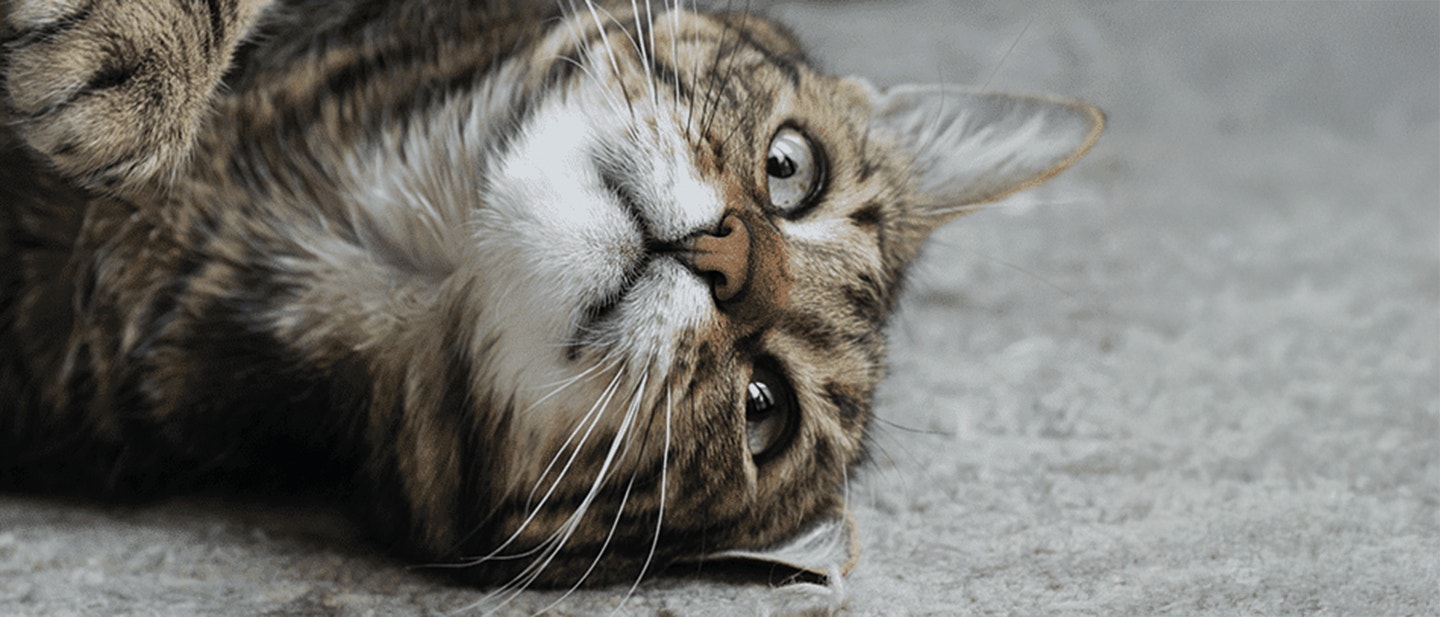
HOW TO GET RID OF FLEAS ON CATS? ESSENTIAL GUIDE

Article checked by a vet
Cat fleas can be a real pain to deal with, both for cats, and cat parents. Fleas on cats are a common health concern, but one that should still be treated as quickly as possible for your cat’s long-term health and comfort.
In this article, we’ll take a closer look at how cats can pick up fleas, how you can identify when your cat has fleas, and how to get rid of fleas on cats fast to keep your pet as comfortable and healthy as possible.
What are fleas and what do they look like on cats?
The most common type of fleas are cat fleas, otherwise known by their scientific name ctenocephalides felis. Fleas on cats look like dark brown insects with flat-surfaced bodies and 3 pairs of legs. They are very small, ranging between 1-3 mm in length, making them difficult to detect. Their eggs are even smaller, no more than 0.5 mm in size, and flea eggs look like tiny grains of white rice on cats.
While you may spot a live cat flea on your cat’s fur, you’re more likely to notice flea dirt. Cat flea dirt looks like small dark specks, which are actually the flea’s faeces. This is usually evidence that your cat has got fleas.
You can tell if your cat has fleas by checking around their groin area, under their armpits, behind their neck, shoulder and legs, and around the base of their tail. These are all humid areas where cat fleas thrive best and are therefore where they will usually bite.
Understanding the problem of cat fleas
Before you think about how to get rid of fleas on cats, it’s important to understand a little bit about the issue.
Fleas are tenacious insects specially adapted to leaping from one animal to another and making themselves comfortable on their new host. This makes fleas on cats one of the most common health issues cat parents have to worry about. A single female flea can lay an incredible 50 eggs per day once they’re settled in your cat’s fur, potentially making the issue a lot worse in a short space of time.
Some common ways that cats can pick up fleas include:
Outdoor cat:
Cats going outside are more likely to encounter fleas. Sources of fleas include the garden, other flea-infested areas, or interactions with wild animals.
- Other animals:
Cats may catch fleas from hunting mice and birds or from contact with other infested animals. If you have other pets in the house, such as rabbits or dogs, then your cat could get fleas from them. - Irregular treatments:
If you’re not keeping up with your cat’s preventive flea treatments, they lack the defences to manage flea infestations. There are a variety of flea treatments available and it’s essential to treat your cat regularly for it to be effective. - New home:
Whilst your new home may look perfectly clean, there is always the chance there are hidden fleas around. If you’ve recently moved and you notice your cat with flea symptoms, make sure to clean your new home thoroughly. If the problem persists, contact your local flea control to help.
Wherever your cat happens to pick up their unwanted hitchhikers, it’s important to find out how to get rid of fleas on cats fast to reduce the chance of further health problems.
How to identify flea infestations in cats?
Knowing how to identify fleas on cats is the first step towards knowing how bad of a problem you’re facing and the right way to approach treatment.
Here are some of the common signs to look out for if you’re worried you may need to think about how to get rid of fleas on cats.
Constant scratching and biting
Similar to head lice in humans, one of the common signs of fleas on cats is excessive scratching in response to the irritation from their bites. Cats may also nibble a particular part of their fur excessively in reaction to fleas.
Overgrooming
Cats love to groom themselves, so sometimes it can be hard to tell when they’re doing it more than usual. If you notice your cat constantly overgrooming one area of themselves, this could be a sign that they have fleas.
Irritability
Cats with fleas are constantly dealing with itches that they can never seem to scratch. Naturally, this will make a lot of cats behave more irritable than usual.
Bumps and scabs
Flea bites look like red scabs on your cat’s skin, caused by your cat scratching the bite area and making it sore. Your cat may be particularly sensitive to flea saliva if the area of skin becomes inflamed - a sign that your cat has got flea allergy dermatitis - and your cat will need to see a vet for treatment.
Anaemia
In some severe cases of a flea infestation, cats can show signs of anaemia such as a decreased appetite, pale gums, weakness and lethargy. This is most common in kittens and senior cats, as their bodies struggle to cope with the loss of blood if there are lots of fleas feeding on them.
Flea dirt
Flea faeces, commonly called “flea dirt”, will appear as dark specks in your cat’s fur that can be visible by parting their fur and checking close to the skin and also after brushing your cat or treating them with a flea comb.
To check if the debris in your cat's coat is flea dirt, simply dampen a piece of cotton wool and place some of the dirt on it, if red seeps out of the 'dirt' it is flea faeces made up of digested blood.
Remember that some of the common flea symptoms in cats can be the sign of other, unrelated health issues. You can reduce the risk of illness in your cat with nutritionally balanced food like Perfect Fit™ Junior Cat Food.
What is the easiest way to get rid of fleas on a cat?
Topical treatments like Spot On are the most effective way to get rid of fleas on cats. This is designed to be absorbed into your cat’s skin to kill the fleas that ingest your cat’s blood. It also prevents new flea eggs from developing. Speak to your vet practice to understand the products they advise you to use.
Here are some other treatments you may want to check out if you’re wondering how to get rid of fleas on cats fast, how often you should flea a cat, or anything else related to cat fleas.
Flea collars
Flea collars are made with chemicals that repel fleas and provide ongoing protection against fleas. These are less effective than spot-on treatments.
Oral flea treatments
Certain oral medications prescribed by a vet circulate through a cat’s blood and kill fleas that attempt to bite them.
Flea shampoos
Though your cat may not love them, flea shampoos are formulated to kill fleas on contact and can be an effective method to treat an infested cat. However, it’s important to consider other options first, as bathing cats is not recommended, and flea shampoos are much less effective than spot-on treatments.
Flea combs
Combs can be used in conjunction with other treatments to remove fleas from the fur physically.
Wash fabrics above 60 degrees celsius
Fleas jump off cats and can settle into their bedding or your clothes, sofas and other soft furnishings. Throw all possibly affected items into a bin bag, and place them into your washing machine to wash on a 60+ degree cycle to kill any fleas.
Hoover the house thoroughly
Fleas tend to live in the environment, and only jump onto your cat to feed. They will lay eggs anywhere - from your carpets or the crevices of your floor to items of furniture and particularly in bedding. It’s essential to hoover the whole house thoroughly and repeatedly to ensure no fleas are remaining. Afterwards, empty out your hoover and wash its waste compartment with warm, soapy water.
Call in an expert
If you’ve carried out the above steps and fleas are still a problem, you might need to call in flea control to help. There are flea sprays you can use on your carpets and soft furnishings to kill persistent fleas, but it’s essential that everybody in the house stays away until surfaces are dry. Always follow the manufacturer's instructions for all products used to treat fleas.
How to prevent your cat from getting fleas?
Like many health issues, it’s important to think about how you can prevent your cat from getting fleas just as much as how often you should flea a cat.
Here are some preventative measures to help reduce your cat’s risk of fleas.
Grooming regularly
Regular grooming keeps your cat looking glossy and helps to prevent flea infestations.
Maintaining a clean environment
Regularly vacuuming your cat's bedding, furniture, carpets, and other fabrics in the home can kill fleas and their eggs, reducing the risk of your cat getting infested.
Keeping outdoor spaces tidy
If you let your cat outdoors, be sure to trim grass and other vegetation where fleas might be lurking. Read our guide on allowing your cat outdoors for more advice on letting your cats explore safely.
Using preventatives
Your vet might recommend using preventatives to prevent flea infestations in the future.
Maintaining a balanced diet
Fleas are attracted to unhealthy coats and skin. With this in mind, providing the optimal nutrition for a cat's unique needs is another important step in preventing fleas on cats.
When to consult a veterinarian about fleas on cats?
While over-the-counter flea treatments can be effective if you suspect your cat has fleas, it’s essential to see a vet as soon as possible for an accurate diagnosis and an effective treatment plan.
When your cat is exhibiting flea symptoms, your vet will be able to advise you on the best course of treatment on how often you should flea a cat.
Final thoughts
Fleas are something that many cat parents have to deal with at some point, but knowing what to look out for and the treatment options available can help you take the right preventative steps and keep your cat as comfortable as possible.
For more helpful information on looking after your cat’s health, be sure to check out our guide on the optimal nutrition for cat's immune system.
